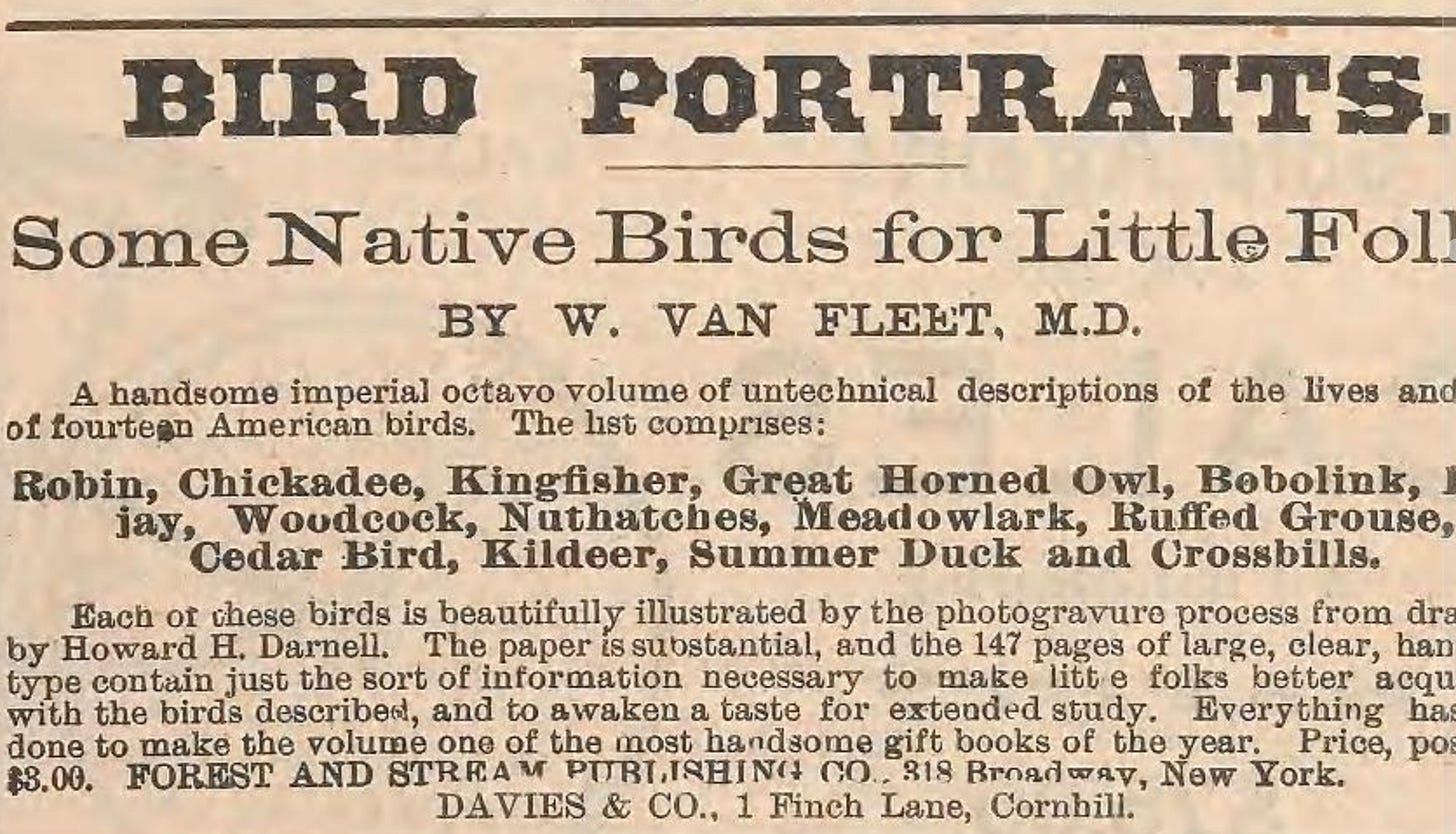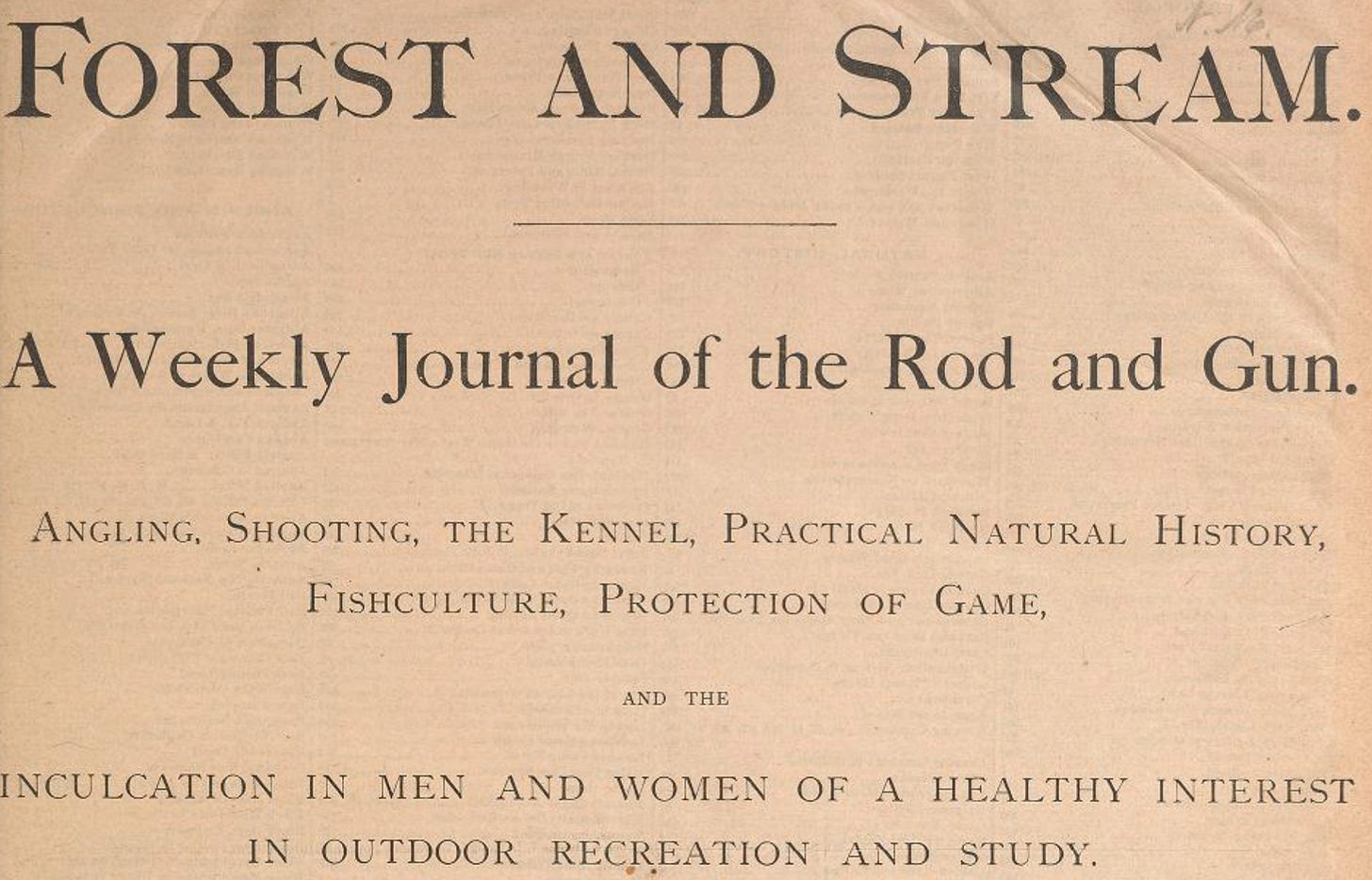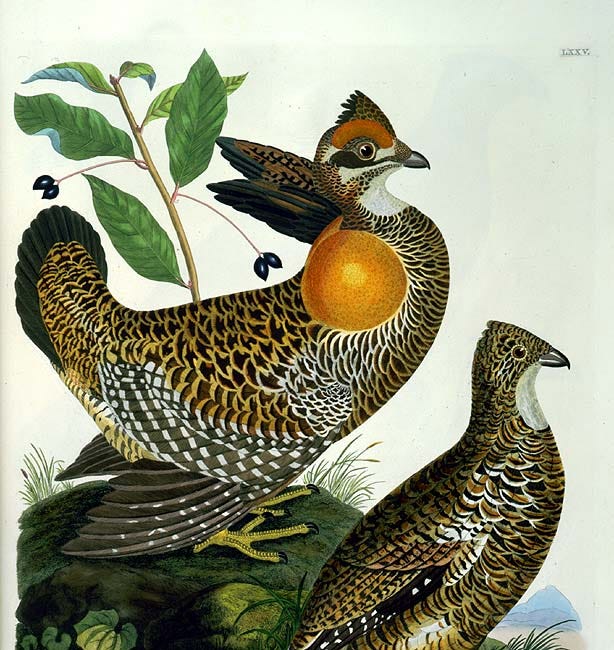'A healthy interest in outdoor recreation and study'
Forest and Stream reflected a time when there were fewer barriers among nature lovers; a bird-focused exhibition opens this Friday
The winter of 1889-1890 was a good one for fans of Evening Grosbeaks, the stocky finches of the far north that only come south every few years. The birds moved into the northern United States that winter and reports were coming in from New Hampshire, Massachusetts, and New York. It was a Forest and Stream correspondent from Irving Park, Illinois, who wrote that while strolling on the banks of the Des Plaines River, he shot an Evening Grosbeak in “very fine plumage.”
Forest and Stream billed itself as a weekly journal of the “rod and gun.” In the same pages, there were reports on target shooting competitions, dog shows, and, of course, fishing and hunting. But there were also reports on natural history—what we’d consider birding now.
The advertisements at the back of each issue reflected the magazine’s coverage. Guns and ammo, fishing rods and lures, and the occasional bird-related item.
In a section called Answers to Correspondents, the editors dutifully answered many a random query about the natural world in a time before Wikipedia and Google. (Sample question: What is the difference between a hare and a rabbit?)1
The pages of Forest and Stream reflect a time when perhaps there were fewer categories and fewer boundaries between sportsman and naturalist. Or even other forms of outdoor leisure, whether canoeing or training dogs or yachting.
It was a more rural nation, an eighth as large as now. Just a generation before, hunting and fishing for sustenance was a very real thing. For some, it still was. Just the idea of outdoor recreation was a mostly new idea, with the first national parks being founded and railroads making travel more feasible.
It’s not that everyone was included or that there weren’t gradations of degrees of difference even within these groups. The “gentleman sportsman” ideal took precedence in the pages of Forest and Stream. These were business folks who worked and lived in the city and took the train on weekends to places like the Grand Kankakee Marsh in Indiana and Lake Koshkonong in Wisconsin.
The hunters who were in it for the money—the market shooters—were looked down upon. It wasn’t a coincidence that most market shooters were of “Bohemian,”2 Irish, or Italian heritage, newcomers to the states and largely factory laborers, miners, and lumbermen at that. According to some articles, the market shooters took birds without regard to game laws. They also didn’t distinguish among waterfowl, shorebirds, and waders; Chicago restaurant diners were an eager market, too—snipe on toast, anyone?
It was the gentleman sportsmen who were so refined to understand that specific hunting seasons and game laws were what would keep bird populations healthy enough for future years. One wonders though how much of this knowledge was also intended to erect barriers for immigrants and anyone who wasn’t of patrician extraction.
Within the naturalists, there were the professional ornithologists and the amateurs. It’s a divide that still persists today, and there are degrees of difference within these groups, too. Few people ventured into the woods to simply identify birds in 1890. The goal was usually to come home with something—whether a dead specimen they happened upon or one taken by a pocket rifle like that Evening Grosbeak in Illinois.
Everyone of a certain status seemed to read, or contribute articles to, Forest and Stream. The publication itself was a luxury, given that a subscription cost $4 per year. It was an exclusive form of media.
The exhibition that opens Friday will feature a fairly nondescript book called The Sportsman’s Gazetteer and General Guide by Charles Hallock, founder and publisher of Forest and Stream. It’s one of 30 books, postcards, woodcuts, illustrations, and objects that attempt to tell the story of humanity and birds over several centuries. It’s been a sometimes-daunting undertaking as a first-time curator. I hope you’ll visit and take something valuable away from it when you do.
If you liked this newsletter, you also might like this one:
The fate of a lesser-known grouse
The Heath Hen was the most peculiar bird on a peculiar parcel of land on Long Island, New York.
“One difference is that the rabbit burrows, while the hare does not.”
Many Slavic groups got lumped together as Bohemians and still do (speaking as a grandson of immigrants). The reality was that there were Slovaks, Hungarians, Slovenes, Croats, Serbs, Poles, and many more.








Super Interesting. And thanks for the link to the events this summer. I am absolutely interested in checking them out!
Bob, thanks for all this fascinating historical perspective from Forest and Stream! I look forward to taking in the exhibit, but unfortunately will be out of town for the opening. (My Dad used to subscribe to Field and Stream in the early 50s. Any connection to Forest and Stream? Or maybe I just misremember the title of the journal. Susanne